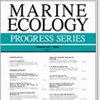Effects of food supply on northern bay scallops Argopecten irradians reared under two pCO2 conditions
IF 2.1
3区 环境科学与生态学
Q2 ECOLOGY
引用次数: 0
Abstract
ABSTRACT: For calcifying organisms such as bivalves, short-term exposure to increased ocean acidification (OA; elevated pCO2) may reduce growth rate, increase mortality, and disrupt shell formation. A growing body of research suggests that clearance rates and what particles bivalves select may change under high pCO2 exposure; however, these experiments are acute, ranging from days to weeks. The effects of food supply on bivalves under long-term OA exposure remain incompletely understood. In this study, juvenile northern bay scallops Argopecten irradians (Lamarck) that had been reared since 4 h post-fertilization under one of 2 OA conditions (∼500-600 or ∼750-850 µatm pCO2; ∼1.37-1.5 or ∼1.0-1.2 Ωaragonite), were subjected to 2 food levels for 42 d (low food: ∼400, high food: ∼1400 chlorophyll cells ml-1). Standard metabolic rate (SMR) and clearance rate (CR) were measured on Day 0, and SMR, CR, growth, and survivorship were measured at 14 and 42 days of exposure to 2 food levels for each of the OA treatments. Juveniles under food scarcity had reduced survivorship and growth independent of OA treatment. We found no effect of OA treatment or an OA × food interaction for these metrics. There was only a food-level effect for SMR and no OA treatment effect; however, there was an interaction between food and OA for CR. Under elevated pCO2 concentrations, scallops cleared Chaetoceros neogracile (strain Chaet-B) over Tetraselmis chui (strain PLY429) and natural seston. Altogether, these data suggest that tolerance to OA mediated by food may depend on food quality or other characteristics that influence particle selection under short-term experimental challenges.食物供应对两种 pCO2 条件下饲养的北部湾扇贝 Argopecten irradians 的影响
摘要:对于双壳类等钙化生物来说,短期暴露于增加的海洋酸化(OA;pCO2升高)环境中可能会降低生长速度、增加死亡率并破坏贝壳的形成。越来越多的研究表明,在暴露于高 pCO2 的情况下,双壳类的清除率和所选择的颗粒可能会发生变化;然而,这些实验都是急性的,从数天到数周不等。在长期暴露于 OA 的情况下,食物供应对双壳类动物的影响仍不完全清楚。在本研究中,自受精后 4 小时起就在两种 OA 条件(pCO2 ∼500-600 或 ∼750-850 µatm; ∼1.37-1.5或∼1.0-1.2 Ω霰石),在42天内摄入两种食物水平(低摄入量:∼400,高摄入量:∼1400叶绿素细胞毫升-1)。第 0 天测量标准代谢率(SMR)和清除率(CR),第 14 天和第 42 天测量两种食物水平下每种 OA 处理的标准代谢率、清除率、生长和存活率。在食物匮乏的条件下,幼体的存活率和生长率都有所下降,这与OA处理无关。我们没有发现OA处理或OA × 食物交互作用对这些指标的影响。对于SMR,只有食物水平的影响,而没有OA处理的影响;但是,对于CR,食物和OA之间存在交互作用。在pCO2浓度升高的情况下,扇贝对Chaetoceros neogracile(菌株Chaet-B)的清除率高于Tetraselmis chui(菌株PLY429)和天然淤泥。总之,这些数据表明,食物介导的对 OA 的耐受性可能取决于食物质量或其他特征,这些特征会影响短期实验挑战下的颗粒选择。
本文章由计算机程序翻译,如有差异,请以英文原文为准。
求助全文
约1分钟内获得全文
求助全文
来源期刊

Marine Ecology Progress Series
环境科学-海洋学
CiteScore
5.30
自引率
8.00%
发文量
238
审稿时长
3 months
期刊介绍:
The leading journal in its field, MEPS covers all aspects of marine ecology, fundamental and applied. Topics covered include microbiology, botany, zoology, ecosystem research, biological oceanography, ecological aspects of fisheries and aquaculture, pollution, environmental protection, conservation, and resource management.
 求助内容:
求助内容: 应助结果提醒方式:
应助结果提醒方式:


